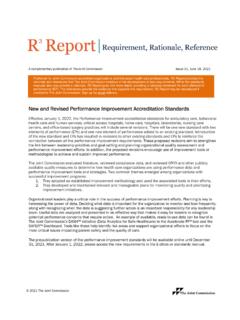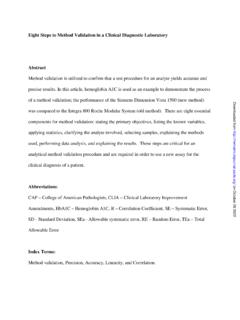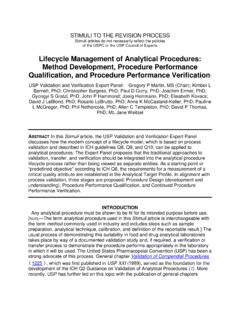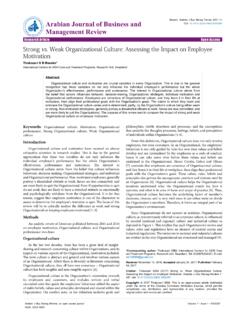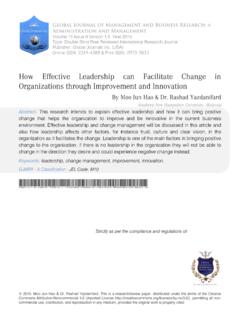Transcription of Assessing Microbial Safety of Drinking Water
1 Assessing Microbial Safety of Drinking Water IMPROVING APPROACHES AND METHODS Published on behalf of the World Health Organization and the Organisation for Economic Co-operation and Development byThis book is one of a series of texts developed to support the development of Microbial aspects in the third edition of WHO's Guidelines for Drinking - Water Quality and to provide guidance to policy-makers, regulators and practitioners in aspects of planning and implementation. The other volumes include: Protecting groundwater for health: managing the quality of Drinking - Water sources Protecting surface Water for health: managing the quality of Drinking - Water sources Water quality and Drinking - Water treatment: the impact of treatment processes on Microbial Water quality and occurrence of pathogens and indicators in surface waters Microbial Water quality in piped distribution systems: a review of knowledge and practice Managing Water in the home: accelerating health gains from improved Water quality Water Safety plans: managing public Water supplies for Safety Other texts of direct relevance include: From WHO Water Quality.
2 Guidelines, standards and health Legionella and the prevention of legionellosis A separate series of texts deals with emerging issues in Water and infectious disease Pathogenic mycobacteria in Water Hazard characterization for pathogens in food and Water (WHO and FAO) Quantifying public health risks in the Guidelines for Drinking - Water Quality: a burden of disease approach From OECD OECD Proceedings. Biotechnology for Water use and conservation: The Mexico '96 Workshop (1997) The price of Water : trends in OECD countries (1999) Molecular technologies for safe Drinking Water (1998) (available at ) Drinking Water and infectious disease: establishing the links (co-published by IWA, 2002) 3 FOREWORDI nadequate Drinking Water supply and quality and poor sanitation areamong the world s major causes of preventable morbidity and to the World Health Organization (WHO) estimates, basic hygiene-related diseases have a significant impact on human health.
3 Diarrhoeal diseasealone causes million of the million Water -related deaths per year. Manyof the deaths involve children under five years of age and the pooresthouseholds and communities. The problem is not limited to developingcountries. In member countries of the Organisation for Economic Co-operationand Development (OECD), waterborne outbreaks occur all too , many outbreaks remain undetected, and it is likely that, beyond thereported outbreaks, there is an unrecognised background burden of issues were high on the international policy agenda in the1970s, following the first international conference on the environment, held inStockholm in 1972. However, by the time of the International Drinking WaterSupply and Sanitation Decade (1981-90), interest had begun to wane. In theindustrialised nations, concern focused on chemical contamination, and theinternational agenda moved increasingly towards major environmental issuessuch as global climate change, ozone depletion and was, however, an increasing level of public and professional concernabout Water Safety , fuelled by concerns raised by outbreaks of disease and therecognition of new agents of disease and the challenges they presented to healthprotection.
4 The 1993 Milwaukee outbreak, resulting in an estimated400 000 cases of cryptosporidiosis, clearly underscored the severe consequencesof waterborne outbreaks in OECD countries. The Cryptosporidium outbreakreported in Las Vegas, Nevada, in the spring of 1994 demonstrated the need forbetter understanding of the effectiveness of indicators and treatment processesin controlling waterborne pathogens. It also indicated the need for a re-evaluation of the effectiveness of traditional indicators as a basis for riskmanagement, since the outbreaks occurred in waters that met the safetystandards set by guidelines for traditional index and indicator and health have again moved up the international policy agenda aspart of a more comprehensive understanding of sustainable development. Thisis evident in the declarations from the World Water Forums in Marrakesh(1997) and the Hague (2000) and in the increased co-operation amonginternational agencies, including the programme of co-operation between theOECD and the WHO.
5 The initiative leading to this report is a first product ofthat need to improve assessment and management of the world s sourcesof Drinking Water was highlighted in 1996 at the OECD Workshop onBiotechnology for Water Use and Conservation in Cocoyoc, Mexico. Then, in1998, the OECD Interlaken Workshop on Molecular Technologies for SafeDrinking Water reviewed the effectiveness of Drinking Water supply systems inprotecting against Microbial contaminants and the reliability of currentmonitoring parameters and testing systems. The Interlaken workshop confirmedthe need for better Microbial monitoring parameters and methods for assessingthe Safety of Drinking Water and monitoring and responding to adverse importantly, given the numbers of pathogens which cannot specifically betracked by conventional methods, especially viruses and parasites such asCryptosporidium and Giardia, the workshop recommendations pointed out that business as usual was no longer a viable s Guidelines for Drinking Water Quality provide a scientific basisfor the development of standards and regulations to protect Drinking waterquality and human health.
6 They are used by countries world-wide and areregularly updated in response to new information and developments. A series ofmeetings since 1995 has recommended adoption of a systematic preventivemanagement approach to the control of Microbial risks from catchment toconsumer for Drinking Water . A framework integrating aspects of riskassessment and risk management in Water Safety was developed at a meeting inStockholm (1999). The framework harmonises approaches applied to drinkingwater, wastewater use and recreational Water quality. These include WaterSafety Plans , building upon Hazard Analysis Critical Control Point (HACCP)and the multiple barrier principle . This document (developed by OECD andWHO) is one in a series of state-of-the-art reviews, which will inform theprocess of updating the methods do not effectively identify and prevent serious entericwaterborne disease, and there is a large and under utilised toolbox forimproving assessment of the Safety of Drinking Water .
7 While the rationale forusing index organisms to detect contamination in source Water remains sound,evaluation of treatment efficacy, post-treatment contamination, etc., requiremultiple indicators. No single Microbial (or non- Microbial ) indicator parameter5is adequate to determine if all steps in the entire Drinking Water productionprocess are working properly in all circumstances. Thus, it is necessary to gain abetter understanding of the role and usefulness of the traditional and newparameters for monitoring and of the methods available for their analysis, andof the information needed to initiate appropriate remedial and Swiss Federal Institute for Environmental Science and Technology(EAWAG) heeded the call for a major review of the state of knowledgeregarding monitoring parameters and testing methods relevant to the control ofthe Microbial Safety of Drinking Water . Under the leadership of the Director ofthe Institute, Professor Alexander Zehnder, and with the generous support ofEAWAG, an initiative was launched to develop a guidance document to addresssuch needs, in co-operation with the OECD and the WHO.
8 Responsible for theco-ordination of this initiative were Dr. Mario Snozzi and Dr. Wolfgang K sterof EAWAG, Dr. Jamie Bartram of the WHO, Dr. Elettra Ronchi of the OECDand Dr. Al Dufour of the US Environmental Protection Agency. The successfuloutcome of this initiative is due, however, to the exceptional efforts made by thecontributing international experts. The financial support of the Industry Councilfor Development (ICD) for review and advance document development isgratefully acknowledged. The expert editorial assistance of Dr. Lorna Fewtrelland the secretarial assistance of Alysia Ritter have been of the documentThis guidance document seeks to respond to the need to improve theassessment and management of the microbiological Safety of Drinking Water , bymoving away from using monitoring simply as a tool to verify the Safety (orotherwise) of the finished product towards using the results as a basis for riskmanagement actions.
9 End-product testing comes too late to ensure safe drinkingwater, owing to the nature of current Microbial sampling and testing, whichtypically provides results only after Water has been distributed and oftenconsumed. Thus, this document gives guidance on the appropriate applicationof monitoring parameters for ensuring the Safety of Drinking Water and toinform risk management decisions, with an emphasis on control of faecalcontamination. It offers guidance on how to select and use multiple parametersto meet specific information needs as a support to safe practice throughout thewhole Water system: catchment protection and assessment, source Water qualityassessment, assessment of treatment efficiency, monitoring the quality ofdrinking Water leaving the treatment facility and in the distribution system. Itoffers a comprehensive review of traditional index and indicator organisms andof emerging approach described here has elements of both revolution andevolution.
10 It is revolutionary in that it supports a rapidly emerging approachwhich emphasises the need to change from a single indicator organism,primarily used for end-product monitoring to determine hygienic quality, tomultiple parameters including index and indicator organisms within a broaderintegrated management perspective and a risk management framework. It isevolutionary in that the approach builds upon the multiple barrier approach andon a body of information gleaned from scientific studies and surveys on thenature and behaviour of both pathogens and indicator organisms in watersystems and on the relation between indicator organisms and 1 sets the scene, describing the problem and establishing the needfor monitoring. It outlines the history of faecal indicator parameters anddescribes the various information needs. The use of a range of parameters toassess the examination of process efficiency and operational integrity is outlinedin Chapter 2.










